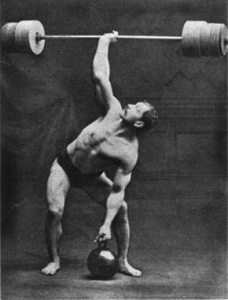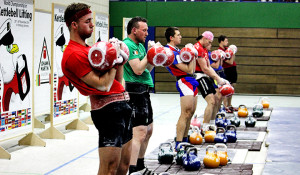Sometimes I feel like I’m being chased by a horde of rounded back zombies. As a coach who deals with regular people that want to learn to lift weights I have to deal with a lot of movement disfunction. People who have been riding a desk for years and don’t have an athletic background often find it extremely difficult to arch their backs and hinge at the hips. I get it. I can work with that. I also see a lot of CrossFitters that have been in the game a few years and still do not have a mechanically sound deadlift. What the fuck is wrong with you? If you have been knowingly deadlifting with a rounded back, you are essentially having unprotected sex with a hooker, while smoking a cigarette on your motorcycle without a helmet.
I feel like I have tried everything to get people to arch their backs when they deadlift (read: yelled a lot), but they just won’t learn. What is a coach to do?
Over the years I have come up with a bunch of different drills that I use to teach people better positions. I decided it was time to put this post together to share them with you. If you are a coach or an athlete struggling with deadlift form, these drills will help. Do them!
Please note. This is NOT the ultimate deadlift article. There are a lot of important nuances to the deadlift that I think we can simply ignore until we get our athletes to maintain a strong tight arch in the back. I believe a neutral spinal position is optimal. However, I think teaching people to be in a tight arch (slightly over extended) position is an important first step as I believe an extended spine is better than a flexed spine. Once they can deadlift with an arched back consistently and proficiently, then cueing a neutral spine is easier to achieve. After this is mastered, we can move on to other important points of performance but protecting the spine is a prerequisite essential.
Cat Cow.
This is a seemingly simple exercise that you should be doing every day just because it feels great. It also has great utility in helping clients learning the difference between arched back and rounded back and eventually being able to move all your joints better. I see many people that struggle with this basic exercise but lots of repetition is key so use it for warmups and cool downs. I add a band in the hip crease to help cue pelvic tilt. When done well you should be able to access anterior and posterior pelvic tilt as well as spinal flexion and extension throughout the lumbar, thoracic and cervical regions. Additionally, the scapulae are moved through elevation and protraction then retraction and depression. If you do not have good movement through your hips, spine or shoulders, then keep doing this exercise every day.
Set Up: on all fours with hands under the shoulders; knees under hips; elbows straight.
Execution: Inhale, anteriorly tilt the pelvis; extend the spine, retract and depress the shoulder blades. Exhale posteriorly tilt your pelvis, flex your spine, elevate and protract your shoulder blades.
Common Faults: bending the elbows; not moving the pelvis; spine or shoulders enough; forgetting to breathe.
Cat Cow from Force Distance Time on Vimeo.
Cat Cow RDL.
Once the athlete can perform perform the Cat Cow, then it is time to add additional movement patterns. Most athletes cannot isolate hip movement from knee movement. By kneeling we can better isolate the hip hinge. This movement mimics a traditional Romanian Deadlift (RDL) which is essentially the top half of the deadlift. Practice this slowly and video it to check yourself.
Set Up: on all fours with hands under the shoulders; knees under hips; elbows straight.
Execution: Inhale, anteriorly tilt the pelvis; extend the spine, retract and depress the shoulder blades. Hold the breath and sit your butt back to your heels drag your hands along the floor until they touch your knees. Exhale, squeeze your butt and open the hips and come to vertical as you slide your hands up your legs. Sit your butt back to the heels as you slide your hands back down your legs to the floor. Come forward on to all fours again.
Common Faults: Pulling the torso to vertical too soon and allowing the hands to come off the floor as they sit their hips back to their heels; Rounding the back as they begin to move the hips; forgetting to breathe; forgetting to go through the Cat Cow stretch every time.
Cat Cow RDL from Force Distance Time on Vimeo.
Banded Good Morning: Anterior to Posterior
The Good Morning and the RDL are essentially hip hinge movements. Hip hinging is the basis of Deadlifts, Kettlebell Swings and, to a large extent, Squats. Most people cannot disassociate the movement of the hips from the movement of the spine which is why they immediately flex their spine when you ask them to hinge. The band in this variation gives a physical cue to the athlete for where they should be hinging from. Watch your athlete closely to see that they are hinging about the hips and not about the spine.
Set Up: Stand with the feel between hip and shoulder width apart. Attach a band in your hip crease and step forward until there is a little tension pulling your hips back.
Execution: Arch your back and send your hips back. Keep hinging forward until you feel like your back is going to round. Allow the band to pull the hips back and feel the tension in your hamstrings. The knees should unlock to allow the hips to move back.
Common Faults: The athlete will continue to flex at the waist and round their back; the athlete does not allow the band to pull the hips back; the knees stay locked; the knees bend and move forward; the athlete tries to squat; the athlete drops their head below their hips.
Good Morning with Band Anterior to Posterior from Force Distance Time on Vimeo.
Banded Good Morning: Posterior to Anterior
This is essentially the same as the previous Good Morning exercise but the band is placed just under the butt pulling the hips forward. The band physically cues the athlete to push their hips back into the band. Most athletes will benefit from both versions but most athletes will click with one or the other so try both to see which one clicks with your athlete.
Set Up: Stand with the feel between hip and shoulder width apart. Attach a band just under your buttocks at the top of the hamstring and step back until there is a little tension pulling your hips forward.
Execution: Arch your back and send your hips back. Keep hinging forward until you feel like your back is going to round. Push the band back with your butt and feel the tension in your hamstrings.
Common Faults: The athlete tries to sit down instead of pushing their hips back; the athlete fails to push the hips back and get pulled forward on their toes; the athlete drops their head below their shoulders; the athlete rounds their back instead of hinging at the hips.
Good Morning with Band Posterior to Anterior from Force Distance Time on Vimeo.
PVC Hip Clamp
Athletes often cannot hinge at the hips because they do not have the ability to tilt their pelvis forward. The anterior tilt of the pelvis can actually lead to a gross exaggeration and over extension of the spine, but for the novice lifter, I feel they have to be able to do this in order to get the back to keep its arch. Furthermore, once the athlete achieves a decent set up position, the spine and pelvis can still reverse position as the athlete begins to take the weight off the floor. This drill builds isometric strength in the hinged position that translates perfectly to the deadlift.
Set Up: Stand with your feet between hip and shoulder width apart. Place a pvc pipe right in the crease of your hip.
Execution: Arch your back and tip your pelvis forward (anterior tilt). Hinge forward and clamp your hips down on the pvc. Take your hands off the pvc and bring them to the side of your head. Continue trying to arch the back harder by lifting your chest. Try to straighten your knees more to load the hamstrings. Try to break the pvc in the crease of your hips. Athletes should be able to hold this position for 60 seconds.
Common Faults: Dropping the pvc pipe; failing to tip the pelvis forward; rounding the back; squatting low to hold the pvc.
Hip Clamp from Force Distance Time on Vimeo.
Midline Stabilization Test
The optimal position for the spine is a braced neutral position. The natural ‘S’ shape of the spine should be wed to the pelvis in an unyielding unit when we perform deadlifts (and all other functional movements). Using the pvc is a great visual and tactile cue to tell whether their spine is maintaining its shape or whether they are letting the shape of the spine deviate as they move. Once this drill is mastered for the deadlift, squat and push press, then the athlete is on their way to great things. Until this drill is mastered, the athlete is always performing sub optimally.
Set Up: Stand up straight with your feet under your hips. Hold a pvc pipe lengthwise along your spine. There should be three points of contact: 1) the back of your head, 2) the back of your shoulders, and 3) the buttocks. There should also be a gap between the pvc and the lower back.
Execution: Hinge at the hips slowly and maintain all three points of contact. Do not let the space at the lower back diminish as you hinge and unhinge. The spine should not change its shape throughout the entirety of the movement.
Common Faults: tilting the neck back; going to fast; rounding the back.
Midline Stabilization Test from Force Distance Time on Vimeo.
Box Deadlift: High StartOnce the athlete demonstrates competency in the previous drills, we can have them start lifting some weight. The set up position of the deadlift is where we see things go wrong before the bar ever leaves the ground. Athletes often struggle with the setup position because they cannot create enough stability in the legs and hips to support an arched back. By placing the athlete on a box, the legs and hips are stable and the athlete can then access their back muscles to create a tight arch.
Set Up: Get a box that places your butt a few inches higher than your knees. Sit on the box with your feet between hip and shoulder width apart. Adjust your feet so that your shins are vertical and roll the bar against your shins.
Execution: Perform a few Cat Cow stretches with your hands on your knees. When the back is arched try to reach down and grab the bar without rounding your back. This requires hinging at the hips and not shifting the knees forward. Before you stand with the bar, try to arch your back harder by lifting your shoulders away from the floor so the arms feel like they are stretching. The bar should leave the ground at the same time the butt lifts off the box.
Common Faults: The athlete tries to lift before arching the back; the athlete rounds the back and shifts the knees forward to get their hands on the bar; the athlete rests their weight in their hands; the bar comes off the ground before the butt leaves the box; the butt comes off the box before the bar leaves the ground.
Box Deadlift High Start from Force Distance Time on Vimeo.
Box Deadlift: Low Start
The next step is to transition from the set up on on the box to a free-standing set up. This drill show the athlete how to set their back first and then transition to free-standing. This drill helps those athletes that are less flexible and find it easier to set their back in a lower set up position.
Set Up: Use a box that places your hips at about the same height as your knees. Place your feet between hip and shoulder width and adjust the feet until your shins are vertical. Roll the bar back to your shins.
Execution: Perform some Cat Cow stretches and set your back in a tight arch. Lean forward and place your hands on the bar. The back should remain arched and the shoulders should be behind the bar. Lift your hips off the box by flexing at the ankles and allowing the knees and the shoulders to move slightly forward until the shoulders move just past the bar. Have the athlete press down through their feet and try to lift their shoulders away from the floor to stretch their arms as they transition off the box. Maintain that arched back and deadlift.
Common Faults: rounding the back as the athlete transitions off the box; resting their weight on the bar; not shifting the shoulders over the bar as they move off the box; shifting the weight into the toes.
Box Deadlift Low Start from Force Distance Time on Vimeo.
Deadlift: Standing Start
Finally the test is to perform some real deadlifts, but the athlete still has to prioritize the arched back. This variation begins each rep with a Cat Cow stretch so the athlete can reinforce the good position before deadlifting.
Set Up: Stand with your hips between hips and shoulder width apart. Roll the barbell back until it touches your shins.
Execution: Place your hands on your knees and perform a few Cat Cow stretches. Maintain a tight arch and bend your knees to get your hands on the bar. Once you have your hands on the bar and your back is arched, try to lift your butt slightly to tighten your hamstrings and then deadlift. Try not to look at the bar when you grab it.
Common Faults: rounding the back as you grab the bar; not bending the knees to get the hands to the bar; looking at the bar as you grab it; shifting the weight to the toes.
Deadlift Setup: Standing from Force Distance Time on Vimeo.



